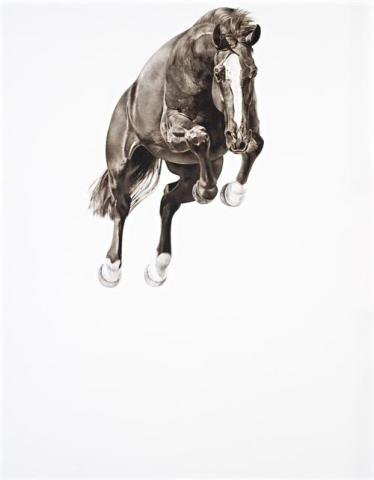SPRING/ FALL 2, 2003
Michael Zavros
oil on canvas
212.0 x 167.5 cm
signed with initials and dated lower right: MZ 03
Mori Gallery, Sydney
Private collection, Sydney
The following are excerpts from Smee, S., 'Brittle Beauty', The Australian, 24 March 2007, a review of the artist's solo exhibition Egoïste which was held at Wollongong City Art Gallery, New South Wales earlier this year.
...Zavros' vision is not directed outwards at the world and how it becomes visible. It is inner-directed. His subject is narcissism. These images correspond, quite deliberately and challengingly, to a kind of vacuum-packed vanity, as airless as it is seductive.
In Zavros' world, it is as if invention, imagination and transformation are too much to hope for. The best the artist can do is obsessively nail down found images, borrowed images, images of such airless beauty that they hold out a promise - however impossible to fulfil - of something surpassingly lovely, pristine, untouchable. The hope - a vain one, in both senses of the word - is that the beautiful image will give the narcissist back to himself. Flesh him out. Fill him in.
...Narcissism, of course, is not a disease. It is an arrested state of development. It is also a condition of our culture. As such, it is almost a precondition of contemporary creativity, one of the premises contemporary artists start out with... They overcome narcissism by committing their primary energies to something beyond themselves. But some provocative and interesting art in recent decades has dared to reflect the malaise, almost to wallow in it.
The tendency in recent art towards literalism (not a sculpture of a shark, but the shark itself; not a painting of a pregnant woman but a Madame Tussaud’s–style copy, replete with individually inserted body hairs) is extended by Zavros into the world of images. We don't, in other words, get a painting that uses photography as the basis for imaginative transformation but a painting that is as close to photography - even to artificially manipulated, art-directed photography - as it is possible to get. We get a reproduction, a copy.
This literal tendency in recent art comes out of minimalism and a contemporary suspicion of symbols and metaphors. No question, it can be depressing. But Zavros' literalism, like the literalism of James Angus, may be richer than it first appears. In his case, the fidelity of the copy implies a kind of obsession, an infatuation. The intensity of the infatuation jams up against the banality of the original image, and this jam perfectly encapsulates the narcissist's condition: the fatigue of it, the ache, the never-enough...
